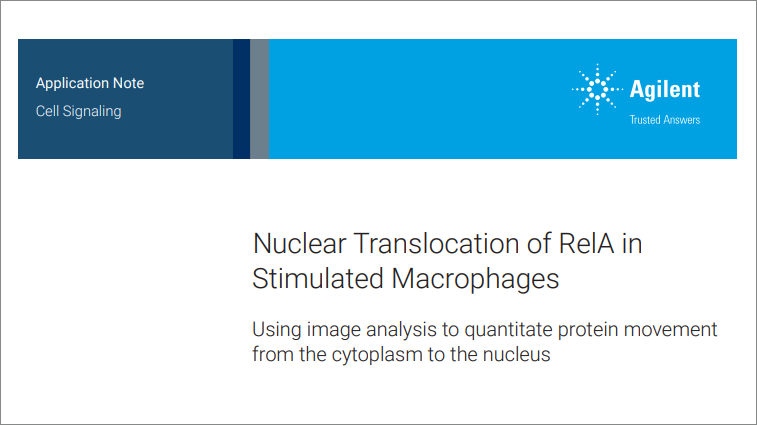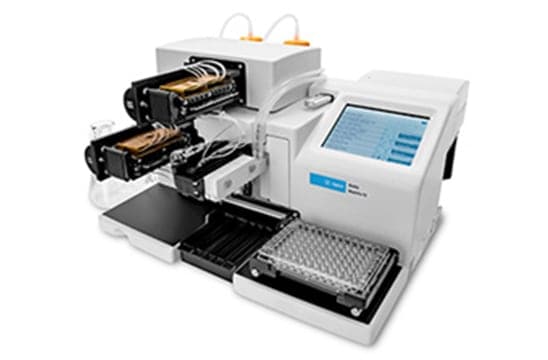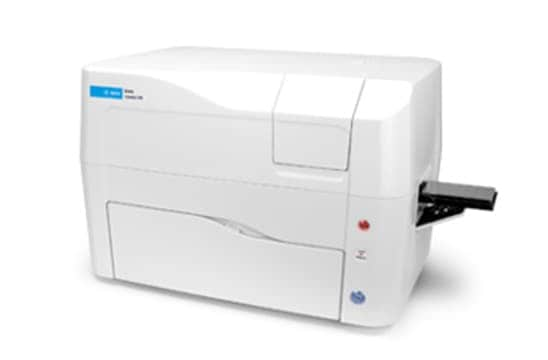Automated Nuclear Translocation Assays
November 2022
Nuclear translocation is a critical cellular mechanism for the function and regulation of eukaryotic cells. In this issue of TekTalk we’ve compiled a variety of resources that highlight automated image analysis techniques for quantifying nuclear translocation events within cell model systems, including tips and best practices for optimizing translocation assays. In the featured application notes below, the Agilent BioTek automated imaging systems and Gen5 image analysis software are employed to monitor changes in intracellular protein location using both endpoint and kinetic live cell applications. The use of nuclear stains and powerful Gen5 dual masking capabilities enable accurate determination of nuclear to cytoplasmic ratios of proteins of interest. The automated microplate-based format supports efficient, high-throughput characterization of treatment response and screening applications.
Featured Applications

Nuclear Translocation of RelA in Stimulated Macrophages
As critical components of the innate immune system, macrophages respond to microbes by recognizing molecules, such as the gram-negative bacteria product lipopolysaccharide (LPS), via Toll-like receptors. Receptor activation stimulates a complex signaling network that involves, among others, the NF-κB pathway. This application note quantitates the nuclear translocation of the protein RelA, a component of the NF-κB transcription factor complex, in macrophages using image-based analysis.

Expression and Intracellular Translocation of Cancer Biomarkers in Hepatocarcinoma Cells Induced by Changes in Mitochondrial Metabolism
Hepatocarcinoma is one of the most common cancer types in the U.S. with limited treatment options and poor survival rate. Recently, cancer bioenergetics emerged as a promising source of targets to develop novel anticancer agents. The identification of relevant biomarkers is essential for screening and validation of small molecules proposed as chemotherapeutic agents. In this regard, there is a great need for high-throughput/high-content methods, which require short, reproducible sample preparation techniques.
Product Spotlight
Agilent BioTek Cytation 5 Cell Imaging Multimode Reader
BioTek Cytation 5 is a modular, upgradable multimode reader that combines automated digital microscopy and conventional microplate detection. Cytation 5 includes filter- and monochromator-based detection; the microscopy module provides up to 60x magnification in fluorescence, brightfield, color brightfield and phase contrast. Incubation to 65 °C, shaking and Gen5 software are standard.
Watch this video to learn more about the complete Cytation line of cell imaging multimode readers.
Tek Tips
Cell handling considerations
RAW264.7 G9 cells require careful handling prior experimental use. They are expanded in non-treated tissue culture flasks such as P/N 15800 T-75 flasks from Nunc. The use of digestive mixtures such as trypsin should be avoided as they will result in cellular activation and a cessation of growth. Cells are detached by adding cold 2 mM EDTA in PBS for 5 minutes.
Fluorescent labeling strategy
- Translocation experiments can be performed with either live imaging or with fixed cells. If the experiment is to be terminated with fixation, the use of cold alcohols should be avoided given that the fluorescence of some molecules, including the RelA-GFP construct, will be abolished with alcohol fixation. The use of 4% paraformaldehyde as a fixative will preserve cell structure without the loss of GFP fluorescence.
- Employing immunofluorescence to detect protein expression across multiple cellular compartments (e.g., nuclear and cytoplasmic) requires pre-optimization of antibody concentrations and incubation times.
- A nuclear marker, such as Hoechst 33342 stain is necessary to identify the nucleus as the primary mask for analysis. The secondary mask identifying the cytoplasm is identified by expanding the primary mask outward. Cells positive for translocation are identified based on the ratio of the nuclear and cytoplasmic fluorescent signal means.
General imaging and analysis considerations
- For accurate detection of labeled antibody signal linked to protein expression, an appropriate imaging objective should be chosen. Typical objective magnifications utilized for protein translocation applications range from 20-60x.
- Following masking of the nuclear cellular compartment using primary cellular analysis, two methods can be incorporated to apply secondary masks and quantify signal from cytoplasmic areas of the cell.
- If average signal outside of the nucleus is the metric of interest, secondary masks should be extended out a set distance in micrometers away from the boundary of the primary mask. Average signal is then quantified within each mask. Cells exhibiting greater protein expression within the cytoplasm typically will yield a greater average signal within the secondary mask.
- If the total area within the secondary mask metric is of interest, secondary masks should be extended as previously explained. A second threshold is then added such that the secondary mask only includes areas of positive signal. Cells exhibiting greater protein expression within the cytoplasm will also yield a greater area of coverage within the secondary mask.
Upcoming Webinar
Spheroids – What, Why and How-to
Wednesday, December 07, 2022 | 12 PM EDT
Speakers: Jamie Stern, Ph.D., Field Applications Scientist, Cell Analysis, Amanda Herberger, PhD, Field Applications Scientist, Cell Analysis, Cody Narciso, Field Applications Scientist, Cell Analysis, Agilent
Over the last seven decades, spheroids have emerged as an attractive model for many scientific fields, including drug development and disease progression. Though spheroids have been in use for an extended period, researchers often have questions about how to take advantage of this 3D system. In this webinar, we will discuss many factors that underlie a successful spheroid experiment, including the considerations that must be given to sample preparation, data capture, and analysis.
Topics will include:
- Benefits of using spheroids
- Spheroid preparation methods
- Tips for spheroid imaging and analysis
Promotions
Complete Your Cell Based Assay Workflow with Agilent Microplates
Sourcing your microplates shouldn't be an added task in preparing your cell-based workflows. Agilent now offers cell culture and imaging microplates so you can complete your workflows seamlessly.
Expect the quality you need with TC surface treatment enhancing the cell attachment while the microplate lid which accompanies every plate maintains a sterile growth environment with a low risk of cross contamination.

Agilent BioTek MultiFlo FX and Secondary Peristaltic Pump Promotion
Buy an Agilent BioTek MultiFlo FX multimode dispenser with a single peristaltic pump (MFXP1 or MFXP2 models) and a secondary peristaltic pump (part number 7210010), and receive a 50% promotion discount on the secondary peristaltic pump.

Agilent BioTek Cytation C10 with Monochromator Module Promotion
Buy an Agilent BioTek Cytation C10 confocal imaging reader containing the “M” module (monochromator-based UV-Vis absorbance, fluorescence, and luminescence), and receive the instrument for the same price as the Cytation C10 without the "M" module.


